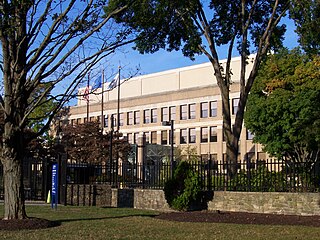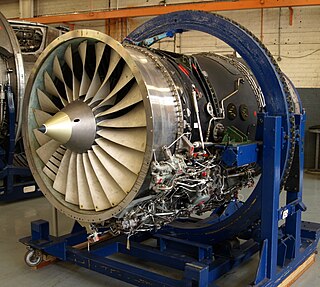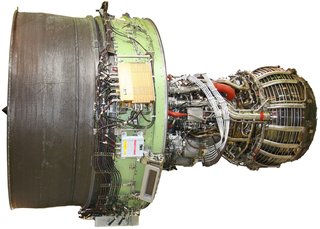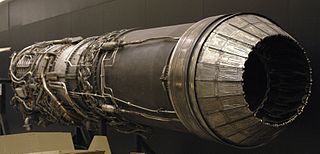Related Research Articles

Pratt & Whitney is an American aerospace manufacturer with global service operations. It is a subsidiary of RTX Corporation. Pratt & Whitney's aircraft engines are widely used in both civil aviation and military aviation. Its headquarters are in East Hartford, Connecticut. The company is the world's second largest commercial aircraft engine manufacturer, with a 35% market share as of 2020. In addition to aircraft engines, Pratt & Whitney manufactures gas turbine engines for industrial use, marine propulsion, and power generation. In 2017, the company reported that it supported more than 11,000 customers in 180 countries around the world.

The bypass ratio (BPR) of a turbofan engine is the ratio between the mass flow rate of the bypass stream to the mass flow rate entering the core. A 10:1 bypass ratio, for example, means that 10 kg of air passes through the bypass duct for every 1 kg of air passing through the core.

The IAE V2500 is a two-shaft high-bypass turbofan engine built by International Aero Engines (IAE) which powers the Airbus A320 family, the McDonnell Douglas MD-90, and the Embraer C-390 Millennium.

MTU Aero Engines AG is a German aircraft engine manufacturer. MTU develops, manufactures and provides service support for military and civil aircraft engines. MTU Aero Engines was formerly known as MTU München.

The Engine Alliance GP7000 is a turbofan jet engine manufactured by Engine Alliance, a joint venture between General Electric and Pratt & Whitney. It is one of the powerplant options available for the Airbus A380, along with the Rolls-Royce Trent 900.

The Rolls-Royce RB.183 Tay is a medium-bypass turbofan engine, developed from the RB.183 Mk 555 Spey core and using a fan scaled directly from the Rolls-Royce RB.211-535E4 to produce versions with a bypass ratio of 3.1:1 or greater. The IP compressor and LP turbine were designed using technology from the RB.211 programme. The engine was first run in August 1984. The Tay 650 had a new HP turbine which incorporated new technology which had been proven with the RB.211-535E4. This engine also had a new combustor for improved durability. The Tay family is used on a number of airliners and larger business jets, including the Gulfstream IV family, Fokker 70 and Fokker 100, with a later version being used to re-engine Boeing 727-100s.

General Electric Company, doing business as GE Aerospace, is an American aircraft engine supplier that is headquartered in Evendale, Ohio, outside Cincinnati. It is the legal successor to the original General Electric Company founded in 1892, which split into three separate companies between November 2021 and April 2024, adopting the trade name GE Aerospace after divesting its healthcare and energy divisions.

IHI Corporation, formerly known as Ishikawajima-Harima Heavy Industries Co., Ltd. is a Japanese engineering corporation headquartered in Tokyo, Japan that produces and offers ships, space launch vehicles, aircraft engines, marine diesel engines, gas turbines, gas engines, railway systems, turbochargers for automobiles, plant engineering, industrial machinery, power station boilers and other facilities, suspension bridges and other structures.

The General Electric GEnx is an advanced dual rotor, axial flow, high-bypass turbofan jet engine in production by GE Aerospace for the Boeing 747-8 and 787. The GEnx succeeded the CF6 in GE's product line.

The General Electric J79 is an axial-flow turbojet engine built for use in a variety of fighter and bomber aircraft and a supersonic cruise missile. The J79 was produced by General Electric Aircraft Engines in the United States, and under license by several other companies worldwide. Among its major uses was the Lockheed F-104 Starfighter, Convair B-58 Hustler, McDonnell Douglas F-4 Phantom II, North American A-5 Vigilante and IAI Kfir.

The Rolls-Royce Trent 900 is a high-bypass turbofan produced by Rolls-Royce plc to power the Airbus A380, competing with the Engine Alliance GP7000. Initially proposed for the Boeing 747-500/600X in July 1996, this first application was later abandoned but it was offered for the A3XX, launched as the A380 in December 2000. It first ran on 18 March 2003, made its maiden flight on 17 May 2004 on an A340 testbed, and was certified by the EASA on 29 October 2004. Producing up to 374 kN (84,000 lbf), the Trent 900 has the three shaft architecture of the Rolls-Royce Trent family with a 2.95 m (116 in) fan. It has a 8.5–8.7:1 bypass ratio and a 37–39:1 overall pressure ratio.
IAE International Aero Engines AG is a Zürich-registered joint venture aeroengine manufacturing company.

The geared turbofan is a type of turbofan aircraft engine with a planetary gearbox between the low pressure compressor / turbine and the fan, enabling each to spin at its optimum speed. The benefit of the design is lower fuel consumption and much quieter operation. The drawback is that it increases weight and adds complexity.

The General Electric CF34 is a civilian high-bypass turbofan developed by GE Aviation from its TF34 military engine. The CF34 is used on a number of business and regional jets, including the Bombardier CRJ series, the Embraer E-Jets, and Comac ARJ21. In 2012, there were 5,600 engines in service.
Turbo-Union Limited is a joint venture of three European aero-engine manufacturers, FiatAvio, MTU Aero Engines and Rolls-Royce.

The Pratt & Whitney Canada PW800 is a series of turbofan engines in the 10,000–20,000 lbf (44–89 kN) thrust class, manufactured by Pratt & Whitney Canada. Intended for the regional jet and business jet market, the gear-less PW800 shares a common core with the larger, geared PW1000G. The first variants were certified on February 15, 2015, to power the new Gulfstream G500/G600. After that it has been certified also for the Dassault Falcon 6X in 2021.
The IAE V2500SF SuperFan was a design study for a high-bypass geared turbofan derived from the IAE V2500. It was offered as the primary engine option for the Airbus A340 in January 1987. Although several customers signed preliminary contracts for this variant, the International Aero Engines board decided in April 1987 to stop the development of the SuperFan, which forced Airbus to partly re-design the A340.

The Ishikawajima-Harima Heavy Industries (IHI) XF5 is a low bypass turbofan engine developed in Japan by Ishikawajima-Harima Heavy Industries for the Mitsubishi X-2 Shinshin (ATD-X).
References
- 1 2 3 4 "International Aero Engines - History". IAE. Archived from the original on 25 January 2013. Retrieved 11 December 2012.
- ↑ Smith, Guy (7 January 1984). "V.2500: the oriental angle". Flight International . Vol. 125, no. 3895. Tokyo, Japan. pp. 29–30. ISSN 0015-3710.
- ↑ "Japanese Aero Engine Corp". Bloomberg . Retrieved 31 March 2020.
- ↑ "Japanese Aero Engine Corporation". japanaerospace.jp. 2016. Retrieved 31 March 2020.
- ↑ "Engine industry revs up". Flight International. 28 September 2004.
